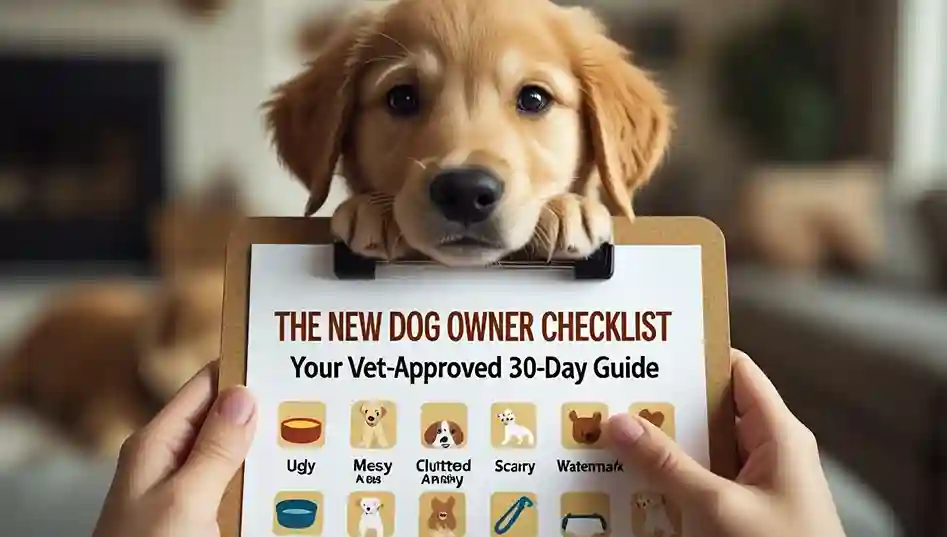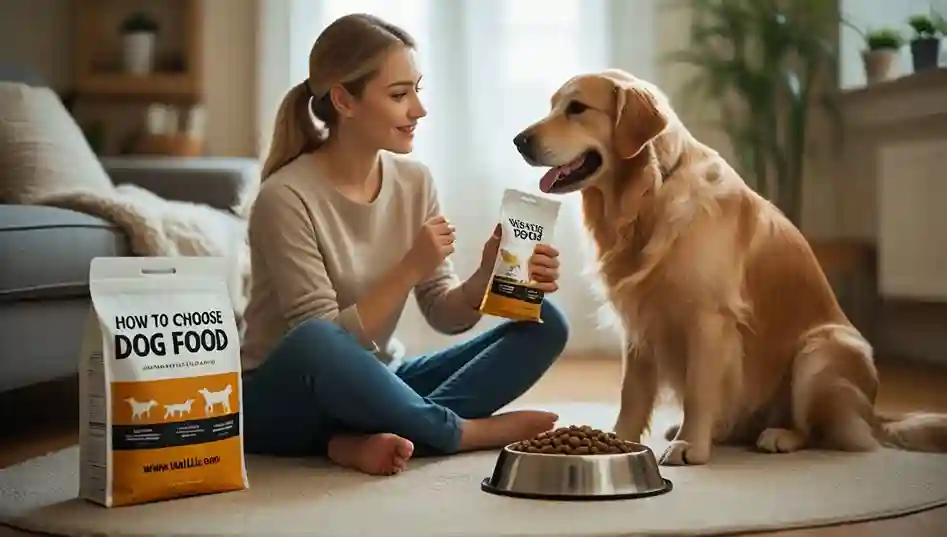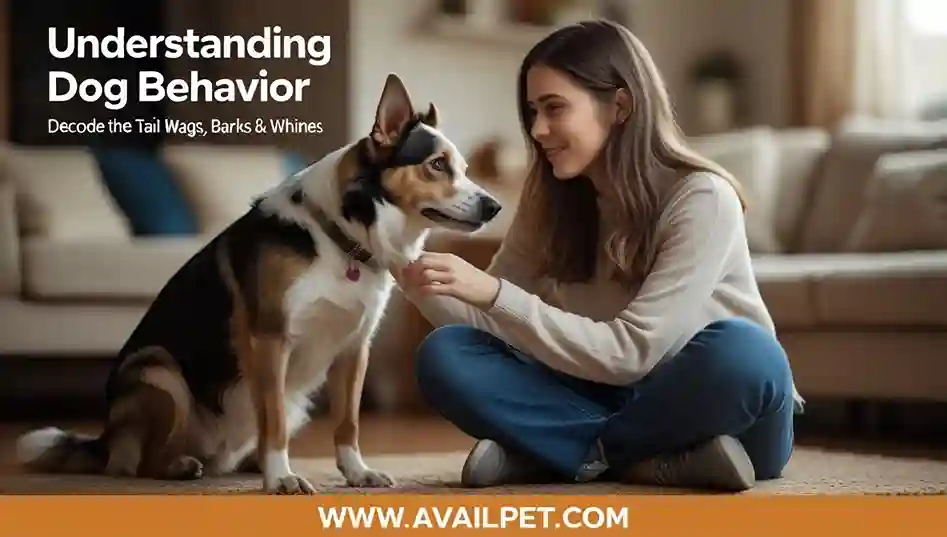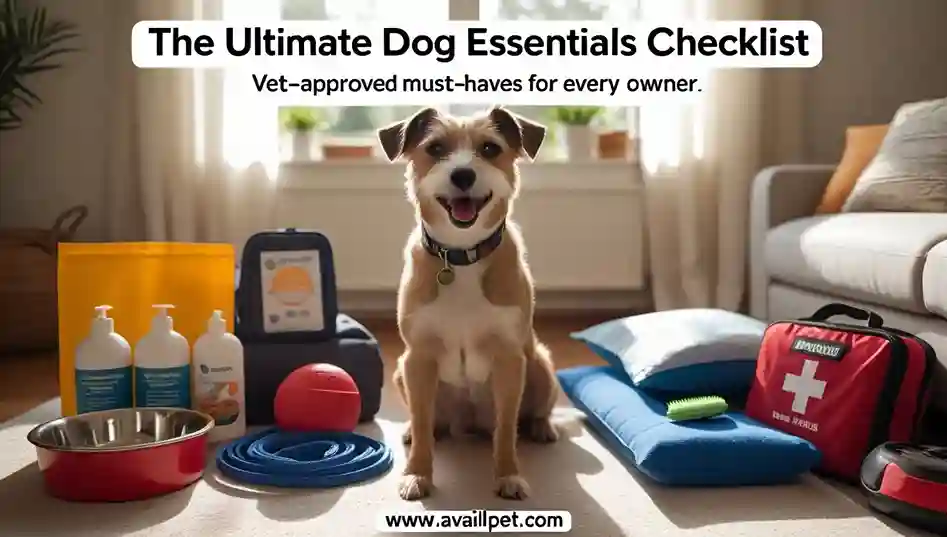Bringing a new puppy home is an exciting adventure, but your familiar environment is filled with unseen dangers to a curious, teething explorer. Puppy proofing your home is not a casual suggestion—it’s an essential, non-negotiable step in responsible pet ownership, forming a core part of the safety section in our ultimate New Dog Owner Checklist. From electrical cords that look like chew toys to common houseplants that can be toxic, proactively identifying and mitigating these risks is the key to preventing emergencies.
This comprehensive, room-by-room guide, reviewed by our veterinary expert, will walk you through the process of creating a safe haven for your new companion. We’ll help you see your home from your puppy’s perspective, pointing out hidden hazards and providing clear, actionable solutions to secure them.
Think of this as your essential pre-puppy safety inspection. Let’s ensure your home is ready for all the joy and none of the accidents.
Key Takeaways: How to Puppy Proof Your Home
Before we dive into the room-by-room details, here are the most critical, vet-approved principles for keeping your puppy safe at home.
- 👀 Get on Their Level: The most important step is to crawl through your home on your hands and knees. You’ll spot choking hazards, loose wires, and tempting items you’d never see from an adult’s height.
- 🔌 Secure All Cords Immediately: Electrical cords are one of the most dangerous—and tempting—chew toys for a teething puppy. Use cord protectors, cable management boxes, or simply unplug and store cords out of reach.
- 🌿 Identify Toxic Plants & Foods: Many common houseplants (like lilies and sago palms) and human foods (like grapes, chocolate, and xylitol) are highly toxic to puppies. Research and remove any potential dangers.
- 🗄️ Lock Away Toxins & Medications: Assume your puppy can open any cabinet. Use childproof locks on cabinets containing cleaning supplies, medications, chemicals, and even trash cans.
- 🚧 Create Safe Zones: Use baby gates and playpens to restrict your puppy’s access to unsafe areas like stairs, offices with lots of wires, and rooms you haven’t fully puppy-proofed yet.
“At a Glance” Comparison Table: Common Household Hazards
| Hazard Category | Specific Examples | Safety Solutions |
|---|---|---|
| Electrical Hazards | Loose power cords, charging cables, power strips, outlets | Cord concealers, outlet covers, cable management boxes, unplugging unused electronics. |
| Toxic Substances | Cleaning products, human medications, certain plants (lilies, sago palms), antifreeze | Childproof cabinet locks, elevated storage, proper plant identification and removal. |
| Choking Hazards | Small toys, coins, hair ties, buttons, children’s toys, bottle caps | Regular floor sweeps, secure trash cans, proper puppy toy selection. |
| Fall & Entrapment Risks | Unsecured stairs, balcony railings, open toilets, gaps behind appliances | Baby gates, window guards, toilet lid locks, appliance gap fillers. |
The Essential Puppy Proofing Toolkit
Before you begin, gather these essential supplies. Having the right tools on hand will make the puppy-proofing process efficient and effective.
Must-Have Safety Products
- Cord Protectors & Cable Management: Use flexible cord concealers like this highly-rated set from Amazon for individual wires and cable management boxes for power strips and electronic hubs.
- Baby Gates: A pressure-mounted gate like this popular extra-wide gate is ideal for doorways, while a hardware-mounted gate provides extra security at the top of staircases.
- Cabinet & Drawer Locks: Simple childproof latches, such as these easy-to-install locks, are essential for lower cabinets in kitchens and bathrooms.
- Bitter Apple Spray: A safe, deterrent spray like this best-selling brand can be applied to baseboards and furniture legs to discourage chewing.
(H3) Household Items to Remove or Secure
- Secure Trash Cans: A sturdy, step-on trash can with a secure lid, like this stainless steel model, can prevent your puppy from raiding dangerous scraps.
- Proper Toy Selection: Provide safe chewing alternatives to your furniture. Durable chew toys like Kong Classics can keep them occupied and out of trouble.
(H3) Emergency Preparedness
- Pet First-Aid Kit: Be prepared for minor scrapes. A pre-assembled pet first-aid kit like this one from the American Red Cross is a great start.
Room-by-Room Puppy Proofing Guide
Follow this detailed inspection list to ensure every area of your home is safe for your new puppy.
Kitchen & Dining Room Dangers
- Secure all lower cabinets containing cleaning supplies, trash cans, and sharp objects.
- Use stove knob covers to prevent accidental gas or burner activation.
- Keep small appliances (toasters, blenders) unplugged and stored away.
- Install refrigerator locks if your puppy is strong enough to open doors.
- Check for food hazards on counters – chocolate, grapes, onions, and sugar-free products.
- Move trash cans to secured cabinets or use pet-proof containers.
Living Room & Bedroom Hazards
- Secure electrical cords behind furniture or use cord protectors.
- Remove toxic plants (peace lilies, pothos, sago palms) or place out of reach.
- Check for small items under furniture – coins, buttons, batteries, children’s toys.
- Use fireplace guards and secure fireplace tools.
- Secure loose curtains and blind cords that could cause entanglement.
- Check under beds for stored items that might be dangerous.
Bathroom Safety Measures
- Keep toilet lids closed with safety latches to prevent drowning or drinking cleaning chemicals.
- Secure medicine cabinets and never leave medications on counters.
- Store personal care products safely – lotions, cosmetics, dental floss can be hazardous.
- Use non-slip mats in bathtubs and on slippery floors.
- Keep laundry baskets elevated – socks and underwear are common choking hazards.
Garage & Yard Security
- Store all automotive products on high shelves – antifreeze is especially dangerous.
- Secure gardening supplies – fertilizers, pesticides, and tools.
- Check fence lines for gaps or weak spots where puppies could escape.
- Remove toxic outdoor plants and mushrooms.
- Cover or secure pools and water features.
- Check for exposed wires or chewing hazards in storage areas.
Buyer’s Guide: Puppy Proofing Essentials
Investing in the right safety products can prevent emergencies and give you peace of mind. Here are our top-rated recommendations for creating a puppy-safe home.
Best Baby Gates for Different Spaces
- For Wide Doorways: The Regalo Easy Step Extra Wide Walk Through Gate expands up to 72 inches and features a walk-through door, making it perfect for large openings.
- For Stairs: The Cardello Retractable Baby Gate offers a sturdy, hardware-mounted solution for the top of stairs, providing maximum security.
- For Odd Spaces: The North States Supergate is versatile and can be configured to fit unusual angles and spaces, perfect for wrapping around fireplaces.
Effective Cord Protection Solutions
- For Multiple Cords: The DTLK Cable Management Box neatly houses power strips and a tangle of cords, preventing access while keeping them organized.
- For Single Cords: Flexible Cord Covers can be wrapped around TV wires and lamp cords, making them less appealing and much safer to chew on.
Safe Puppy Chew Toys vs. Hazardous Items
- Durable Chew Toys: The Kong Classic and West Paw Zogoflex Toppl are excellent for stuffing with treats, providing mental stimulation and a safe outlet for chewing.
- Interactive Toys: Puzzle toys like the Outward Hound Hide-A-Squirrel can keep your puppy engaged and away from forbidden items.
A Veterinarian’s Perspective: Dr. Allona Jackson on Home Safety
“In my emergency practice, I see far too many preventable accidents that stem from simple oversights in the home. Puppies are natural explorers, and their curiosity doesn’t distinguish between a safe toy and a dangerous hazard. What many owners don’t realize is that common household items like electrical cords, certain plants, and even sugar-free gum can become life-threatening emergencies in minutes.
The most effective approach is proactive prevention. Before bringing your puppy home, conduct a thorough safety sweep using this guide. Look for things at their eye level, secure anything that could be chewed or swallowed, and create safe spaces where they can play without constant supervision. Remember that puppy-proofing isn’t a one-time task—it’s an ongoing process as your puppy grows and becomes more mobile and creative in their explorations.
If you’re ever unsure about an item’s safety, err on the side of caution. It’s much easier to prevent an emergency than to treat one.”
— Dr. Allona Jackson, DVM, AvailPet’s Lead Veterinary Consultant
“How We Tested” Methodology
At AvailPet, we believe that pet safety requires both expert knowledge and practical application. Our puppy-proofing protocol was developed through a rigorous, multi-stage process to ensure it effectively addresses real-world risks in modern homes.
- Veterinary Safety Review: This complete home safety guide was developed and medically reviewed by Dr. Allona Jackson, DVM, drawing on her experience with common puppy emergencies seen in veterinary practice. All recommendations align with standards from veterinary toxicology experts.
- Real Home Environment Testing: We implemented these safety measures across various living spaces including apartments, multi-level homes, and houses with yards. The protocol was tested with different puppy breeds known for varying levels of curiosity and chewing behavior.
- Prevention-Focused Approach: Our methodology prioritizes preventing the most frequent and dangerous puppy emergencies, including electrical injuries, toxin ingestion, choking hazards, and fall risks, based on data from animal poison control centers and veterinary emergency rooms.
FAQs About How to Puppy Proof Your Home
What are the most common household items toxic to puppies?
The most dangerous common items include sugar-free products containing xylitol (gum, peanut butter), chocolate, grapes and raisins, medications (both human and pet medications in incorrect doses), household plants like lilies and sago palms, and cleaning products. The ASPCA Animal Poison Control Center website maintains a comprehensive list of toxins.
How do I protect my furniture from a teething puppy?
The key is redirection and management. Provide plenty of approved chew toys like Kongs or rubber chews, and use bitter apple spray on furniture legs as a deterrent. Most importantly, never give your puppy an old shoe or sock to chew on, as they can’t distinguish between your old sneakers and your new ones.
Are there any pet-safe plants I can have in my home?
Yes! Several common houseplants are safe for puppies. These include spider plants, Boston ferns, African violets, and most succulents (like haworthia and echeveria). However, even non-toxic plants can cause stomach upset if chewed in large quantities, so it’s best to keep them out of reach.
What should I do if my puppy chews an electrical cord?
First, ensure the power is off at the circuit breaker before approaching your puppy. Do not touch the puppy while they are still in contact with a live cord. Once safe, check for burns around the mouth, difficulty breathing, or excessive drooling. Contact your veterinarian or an emergency animal hospital immediately, even if they seem fine, as internal injuries can occur.
Conclusion
Creating a safe environment through thorough puppy-proofing is one of the most important and loving actions you can take as a new pet owner. By methodically securing each room and removing hidden dangers, you’re not just protecting your belongings—you’re giving your puppy the freedom to explore and learn safely, which is fundamental to their development and your peace of mind.
This guide works hand-in-hand with other essential new puppy topics. For help establishing good habits, see our guide on how to potty train a puppy, and for understanding their nutritional needs, our puppy feeding schedule by age is an invaluable resource. For a complete overview of everything you need to know in the first 30 days, return to our ultimate New Dog Owner Checklist.
Sources:
- ASPCA Animal Poison Control Center. “Top 10 Pet Toxins.“
- American Veterinary Medical Association (AVMA). “Pet Proofing Your Home.”
- American Kennel Club (AKC). “Puppy Proofing Your Home: A Room-by-Room Guide.”
- Review and expert guidance from Dr. Allona Jackson, DVM.
Full Disclosure: This article contains affiliate links. If you make a purchase through these links, we may earn a commission at no extra cost to you. This supports our research and allows us to continue providing valuable content.
Safety Disclaimer: This guide is for informational purposes and provides general safety recommendations. It is not a substitute for professional veterinary advice or common sense. Always supervise your puppy closely and consult with your veterinarian or a qualified professional for any specific safety concerns.






